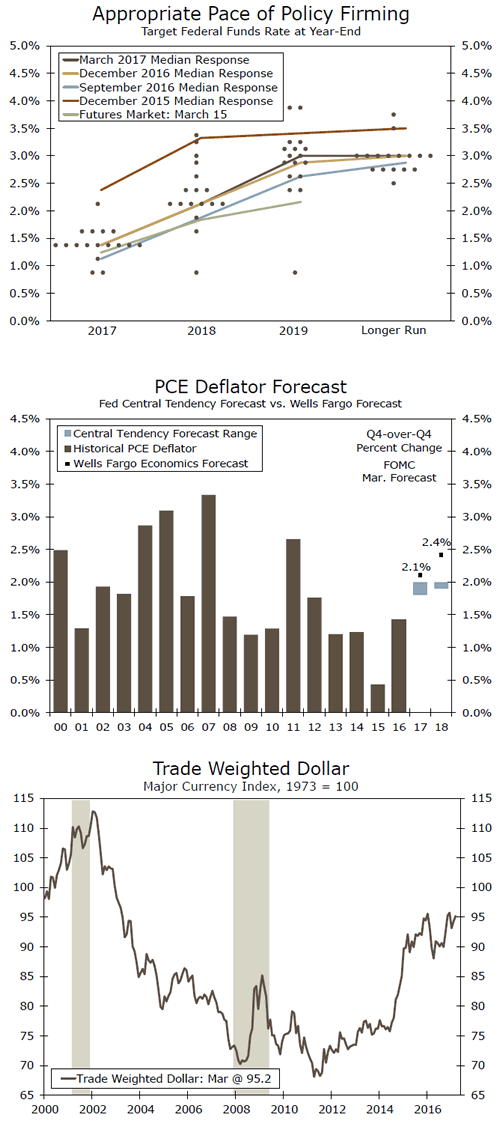For the U.S., economic policy takes on both a domestic and global context. We are a large country in the economic world and our actions have global implications—never more true than with monetary policy.
Rising Rates and The Dot Plot Projections
As expected, the FOMC did raise the fed funds rate target 25 basis points at the meeting today. The median expectation for 2017 remained at three rate hikes, which also remains our forecast. The dots showed 2018 and longerrun projections unchanged, while the median projection for 2019 rose slightly (top chart).
The FOMC, by taking on a preemptive policy action in March, avoids the complication that a surprise French election result or other unforeseen event might upend a June rate hike. A March rate hike puts in place an easier path for the FOMC to raise rates three times in 2017, particularly given that Chair Yellen’s term ends in February 2018.
Meeting Its Goals: A Question on Inflation and a Fog
The minimal changes in the Fed’s dot plot projections were reflected in the economic forecasts. Real GDP growth was left unchanged throughout the forecast horizon with the exception of a 0.1 percentage point upward revision to 2018. In regard to inflation, the projection for the core PCE deflator rose by 0.1 percentage point in 2017; otherwise, the median inflation projections remained unchanged. Inflation, as measured by the PCE deflator, is moving higher but remains relatively tame (middle chart). Meanwhile, in our view, the FOMC’s full employment target has been more or less met. One of the three FOMC policy pillars is that policy should look forward. We expect the FOMC to work on this pillar as an improving economy pushes inflation toward the Fed’s two percent goal.
The Fed’s longer-run median projection for the neutral fed funds rate is three percent; with a two percent inflation target, the real long-run fed funds rate is implicitly one percent. Such a low real funds rate indicates something about potential growth that may not be consistent with the goals of the current administration.
Dollar/Growth and Rates Interactions
U.S. rates serve as the benchmark for global investors as changes in U.S. rates alter yield spreads between sovereign debt returns as well as defining exchange rate risk between countries. With out-of-sync economic cycles, the actual and expected interest rate/growth differentials for the U.S. support the case for the dollar’s increase in value over the last six months (bottom graph) as well as a further increase over the next six months.
Other central banks around the world are challenged. Since the ECB and BOJ are not in a position to raise rates, actions by the Federal Reserve will not be followed and thereby the dollar’s exchange value rises. This will promote financial capital outflows. China is in a more difficult situation since a stronger dollar would increase bilateral trade imbalances and incentivize further capital outflows–difficult results in today’s context.












